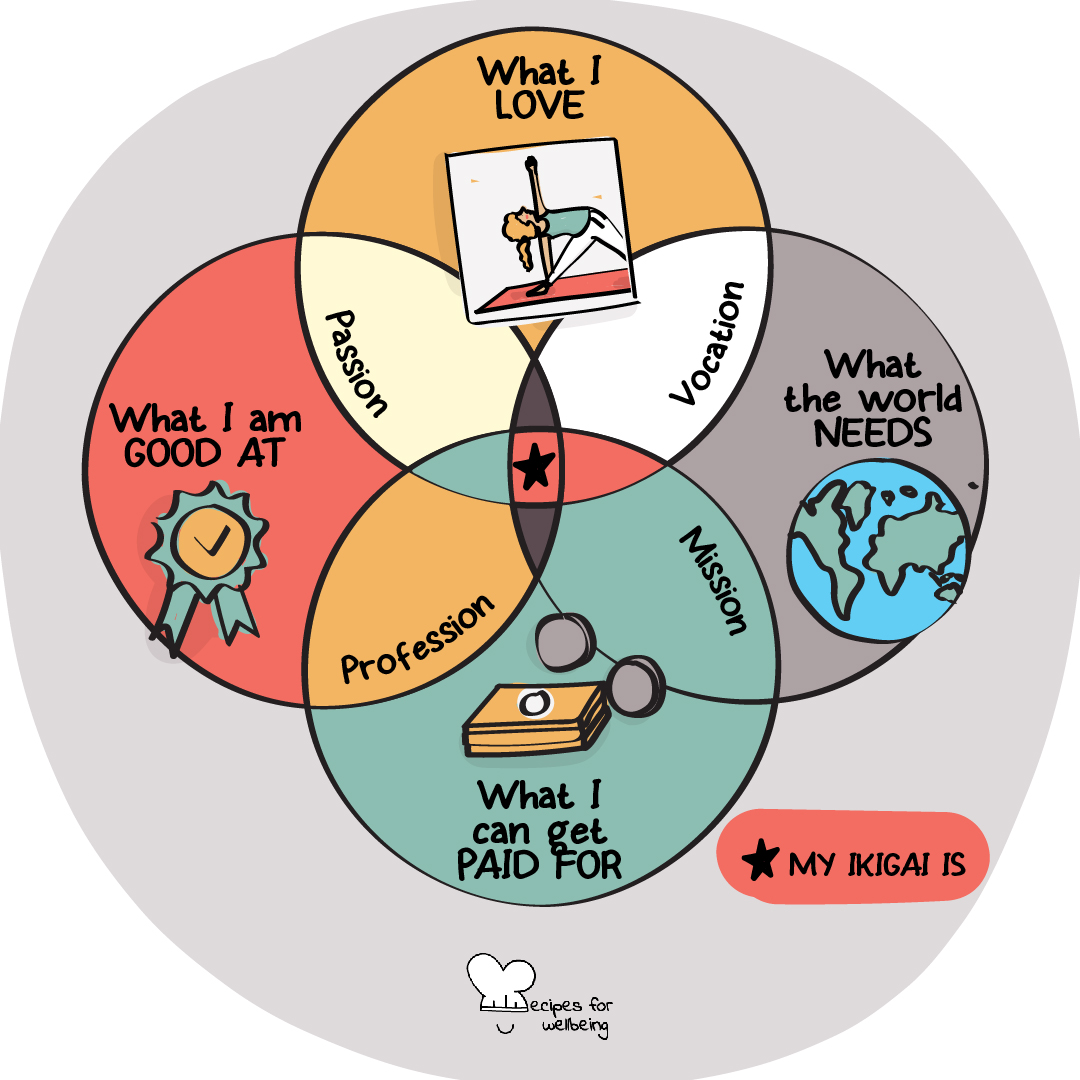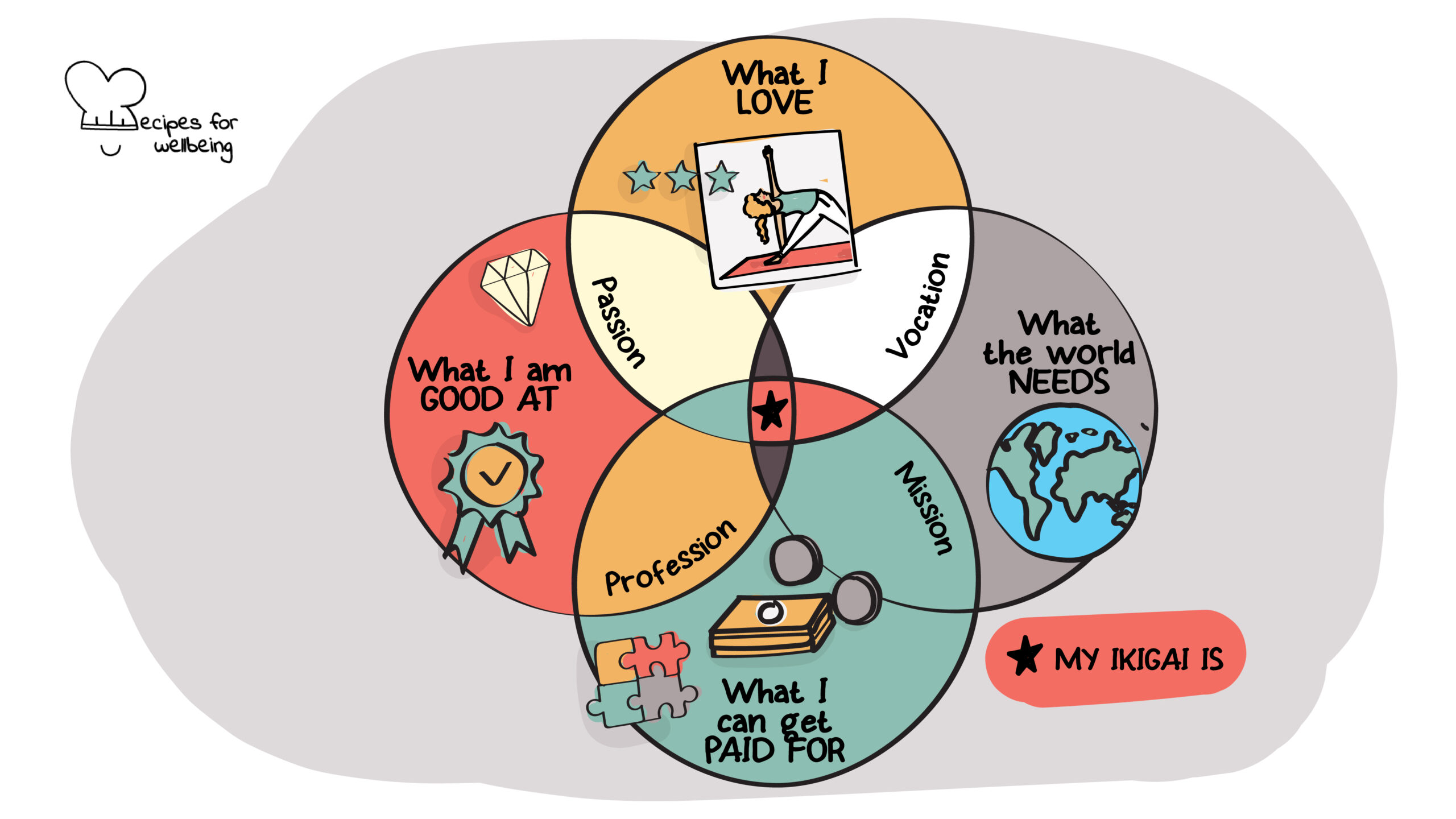
Discover your Ikigai
The place where your deep gladness and the world’s deep hunger meet. ―Frederick Buechner
👥 Serves: 1 person
🎚 Difficulty: Medium
⏳ Total time: 61-120 minutes
🥣 Ingredients: A journal, a pen, coloured markers and pencils, Ikigai diagram printout
🤓 Wholebeing Domains: Accomplishments, Meaning, Positive Emotion
💪 Wholebeing Skills: Commitment, Determination, Direction, Fulfilment, Goal-setting, Joy, Legacy, Purpose

Discover your Ikigai
📝 Description
Exploring the Ikigai diagram step by step.
IKIGAI | 生 ( I) alive, life, to live / き (ki) / 甲斐 (gai) value of doing something.
Ikigai is a Japanese word and Western concept, usually translated as raison d’être or ‘purpose in life’.
The output of this activity is more clarity on who you are at your best and an Ikigai statement, which you can use to identify personally meaningful goals and give direction to your life. Ikigai is a good starting point for finding a meaningful and impactful career. Your work is your biggest opportunity to have a positive impact in the world. Finding work that aligns with your purpose is the difference between volunteering on weekends and spending 75,000 hours dedicated to ensuring collective and planetary flourishing: 40 hours per week, 47 weeks per year, for 40 years.
A sense of purpose or Ikigai can be found at the intersection of the following four questions:
- 💪 What are you good at?
- ❤️ What do you love?
- 🌍 What does the world need?
- 💰 What can you find resources for?
This recipe has been kindly donated by Pascal Kolbe from the Ikigai Lab of the Learning Planet Institute in Paris, France.
👣 Steps
Step 1 – Find out what you love to do ❤️ (10’)
Think about what makes you happy and excited in life. Write down the answers to these questions into your Ikigai diagram.
- What gets you excited in life?
- Which activities make you feel fully engaged and absorbed?
- Is there a specific subject or topic that you find yourself constantly drawn to, wanting to learn more and explore deeper?
- If you had to have roughly the same work day, 5 days a week, for the next 10 years, what activities would you ideally want this work day to consist of?
- If your financial needs were already met for the rest of your life, what would you do then?
Step 2 – Find out what you are good at 💪(25’)
Take this online quiz to find out what your top five strengths are. Read the descriptions of your strengths and write down the ones that match you well. Reflect on the following questions and write down your answers in your Ikigai diagram.
- What am I naturally good at? What seems easy to me? (Focus on strengths and aptitudes more than specific skills.)
- What type of activities do I feel replenished by?
- What am I willing to do even if it taxes me?
- Where have I felt the most pride/satisfaction related to something I did?
Step 3 – Write your passion statement ❤️💪 (10’)
Look back at your answers from step 1 and step 2. See if you notice any patterns of commonalities between them. Write down what makes you feel alive and passionate using simple action verbs. For example: “My passion is to play, love, create, design, and facilitate.”
Step 4 – Explore what the world needs 🌍 (20’)
Think about what problems or issues you care about in the world. You can use the following ways to explore:
- My world: Look first at these pictures that show common problems in the world. Then look at the United Nations Sustainable Development Goals. Write down which ones particularly resonate with you and why.
- My community: Think about what is happening in your family, neighbourhood, city, or country. Write down what you think needs to be improved or changed and why.
- Myself: Sometimes your purpose comes from your own struggles or challenges. Think about what you have overcome or learned from in your life. Write down how you can use your experience to help others who are going through the same.
Now, take some time to write down your reflections in your Ikigai diagram. If you could defend only one of these causes, what would it be?
Step 5 – Find out what you can be paid for ♥️💪🌍 → 💰(25’)
Think about how you can use your passion and skills to make a difference in the world and earn money. Write down the answers to these questions in your Ikigai diagram.
- Who are some people that you admire or respect related to the cause you care about? What are they doing and how do they make money?
- What kind of work do you enjoy doing that with some creativity, you could make a living from?
- What skills or talents do you have that are in demand? (You might need to do some online research.)
- What are some new or growing opportunities in the professional areas that you care about?
Step 6 – Brainstorm your Ikigai statement 🌍♥️💪💰 → ✨(15’)
Now take your journal (or a sheet of paper) and, looking at what you wrote in your Ikigai diagram, brainstorm your Ikigai statement.
- Write “My Ikigai is to…” at the top of the journal / sheet of paper.
- Looking at the notes in your Ikigai diagram, brainstorm at least 15 ideas, e.g. to discover freely, to heal our hearts and connect deeply, to learn how to enjoy life as much as possible… Try to write down at least 15 ideas and don’t worry if some of them seem silly or unrealistic. Let the pen guide you.
- Now look at your list and underline the words or phrases that really touch your heart, that make you feel a strong emotion. For example, you might underline “to discover freely” because it excites you.
- At this point, look for patterns or themes across the words or phrases you underlined. Group them together in a way that makes sense to you. For example, you might group “to discover freely” and “to travel to new places” together because they are both about exploring the world.
- Finally, write a sentence that summarises the groups you created. This is your Ikigai statement. It should state what you want to do with your life, how you want to make a difference, and what makes you happy.
Step 7 – Write your Ikigai statement ✨(10’)
Use the following criteria to write up a good Ikigai statement.
- Short and easy to understand: Keep it to one sentence to ensure that it is truthful because it forces you to state only what matters the most.
- Impact-focused: Make sure to state the impact of your work and your positive effect on others.
- Action-oriented: It should clearly state how you are adding value to others’ lives.
Here are a couple of examples of Ikigai statements:
- “My Ikigai is to find tailored solutions in order to contribute to the overall wellbeing of people suffering from health problems.” (Michael)
- “My Ikigai is to co-create innovative pedagogies in order to help thrive those who have been forgotten by society.” (Clara)
When you are satisfied with your Ikigai statement, write it down on page 2 of your Ikigai diagram.

